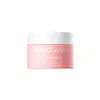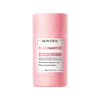What's inside
What's inside
 Key Ingredients
Key Ingredients

 Benefits
Benefits

 Concerns
Concerns

 Ingredients Side-by-side
Ingredients Side-by-side

Water
Skin ConditioningKaolin
AbrasiveGlycerin
HumectantCetearyl Alcohol
EmollientDipropylene Glycol
HumectantOryza Sativa Bran Oil
EmollientEthylhexyl Palmitate
EmollientCI 77891
Cosmetic ColorantPolysorbate 60
EmulsifyingDimethicone
EmollientLactobacillus/Punica Granatum Fruit Ferment Extract
Skin ConditioningNiacinamide
SmoothingMagnesium Aluminum Silicate
AbsorbentPEG-100 Stearate
Glyceryl Stearate
Emollient1,2-Hexanediol
Skin ConditioningHydroxyacetophenone
AntioxidantXanthan Gum
EmulsifyingPEG-20 Stearate
EmulsifyingHydroxyethyl Acrylate/Sodium Acryloyldimethyl Taurate Copolymer
Emulsion StabilisingChlorphenesin
AntimicrobialBisabolol
MaskingButylene Glycol
HumectantAllantoin
Skin ConditioningPolyisobutene
Pentaerythrityl Tetra-Di-T-Butyl Hydroxyhydrocinnamate
AntioxidantEthylhexylglycerin
Skin ConditioningDisodium EDTA
CI 77491
Cosmetic ColorantGentiana Scabra Root Extract
Skin ConditioningPEG-7 Trimethylolpropane Coconut Ether
EmulsifyingAroma
Polysorbate 80
EmulsifyingPropylene Glycol
HumectantSorbitan Isostearate
EmulsifyingPentylene Glycol
Skin ConditioningLactobacillus/Soymilk Ferment Filtrate
Skin ConditioningCaprylyl Glycol
EmollientPhenoxyethanol
PreservativeSodium Hyaluronate
HumectantMaltodextrin
AbsorbentSalicylic Acid
MaskingAcacia Senegal Gum
MaskingArtemisia Vulgaris Extract
Skin ConditioningTocopherol
AntioxidantCentella Asiatica Leaf Extract
Skin ConditioningAlchemilla Vulgaris Extract
AstringentTrehalose
HumectantPanicum Miliaceum Seed Extract
Skin ConditioningSophora Flavescens Root Extract
AntioxidantOpuntia Ficus-Indica Stem Extract
Skin ConditioningOphiopogon Japonicus Root Extract
Skin ConditioningHibiscus Abelmoschus Seed Extract
MaskingPyrus Cydonia Seed Extract
MaskingSecale Cereale Seed Extract
AbrasiveGlycine Soja Seed Extract
Skin ConditioningLactobacillus Ferment
Skin ConditioningLeuconostoc/Radish Root Ferment Filtrate
AntimicrobialCastanea Sativa Seed Extract
Skin ConditioningHelianthus Annuus Seed Extract
Skin ConditioningWater, Kaolin, Glycerin, Cetearyl Alcohol, Dipropylene Glycol, Oryza Sativa Bran Oil, Ethylhexyl Palmitate, CI 77891, Polysorbate 60, Dimethicone, Lactobacillus/Punica Granatum Fruit Ferment Extract, Niacinamide, Magnesium Aluminum Silicate, PEG-100 Stearate, Glyceryl Stearate, 1,2-Hexanediol, Hydroxyacetophenone, Xanthan Gum, PEG-20 Stearate, Hydroxyethyl Acrylate/Sodium Acryloyldimethyl Taurate Copolymer, Chlorphenesin, Bisabolol, Butylene Glycol, Allantoin, Polyisobutene, Pentaerythrityl Tetra-Di-T-Butyl Hydroxyhydrocinnamate, Ethylhexylglycerin, Disodium EDTA, CI 77491, Gentiana Scabra Root Extract, PEG-7 Trimethylolpropane Coconut Ether, Aroma, Polysorbate 80, Propylene Glycol, Sorbitan Isostearate, Pentylene Glycol, Lactobacillus/Soymilk Ferment Filtrate, Caprylyl Glycol, Phenoxyethanol, Sodium Hyaluronate, Maltodextrin, Salicylic Acid, Acacia Senegal Gum, Artemisia Vulgaris Extract, Tocopherol, Centella Asiatica Leaf Extract, Alchemilla Vulgaris Extract, Trehalose, Panicum Miliaceum Seed Extract, Sophora Flavescens Root Extract, Opuntia Ficus-Indica Stem Extract, Ophiopogon Japonicus Root Extract, Hibiscus Abelmoschus Seed Extract, Pyrus Cydonia Seed Extract, Secale Cereale Seed Extract, Glycine Soja Seed Extract, Lactobacillus Ferment, Leuconostoc/Radish Root Ferment Filtrate, Castanea Sativa Seed Extract, Helianthus Annuus Seed Extract
Water
Skin ConditioningGlycerin
HumectantButylene Glycol
HumectantTitanium Dioxide
Cosmetic ColorantVolcanic Soil
Skin ConditioningMica
Cosmetic ColorantKaolin
AbrasiveNiacinamide
SmoothingDiglycerin
HumectantArbutin
AntioxidantSodium Palmitate
CleansingBeta-Glucan
Skin ConditioningPanthenol
Skin ConditioningMineral Salts
Skin ConditioningTranexamic Acid
AstringentSodium Hyaluronate
HumectantRhamnose
HumectantJojoba Wax PEG-120 Esters
PEG-40 Hydrogenated Castor Oil
EmulsifyingCI 77491
Cosmetic ColorantCI 77492
Cosmetic ColorantMenthyl Lactate
MaskingCI 45380
Cosmetic ColorantGlycyrrhiza Glabra Root Extract
BleachingPunica Granatum Fruit Extract
AntioxidantHydroxypinacolone Retinoate
Skin ConditioningPhenoxyethanol
PreservativeCaprylyl Glycol
EmollientAroma
Ethylhexylglycerin
Skin ConditioningDimethyl Isosorbide
SolventWater, Glycerin, Butylene Glycol, Titanium Dioxide, Volcanic Soil, Mica, Kaolin, Niacinamide, Diglycerin, Arbutin, Sodium Palmitate, Beta-Glucan, Panthenol, Mineral Salts, Tranexamic Acid, Sodium Hyaluronate, Rhamnose, Jojoba Wax PEG-120 Esters, PEG-40 Hydrogenated Castor Oil, CI 77491, CI 77492, Menthyl Lactate, CI 45380, Glycyrrhiza Glabra Root Extract, Punica Granatum Fruit Extract, Hydroxypinacolone Retinoate, Phenoxyethanol, Caprylyl Glycol, Aroma, Ethylhexylglycerin, Dimethyl Isosorbide
Ingredients Explained
These ingredients are found in both products.
Ingredients higher up in an ingredient list are typically present in a larger amount.
Aroma refers to an ingredient, or mixture of ingredients, that impart or mask a flavor.
The name is slightly confusing. This is because INCI associates aroma with flavor instead of smell.
Here is the official definition from the The International Cosmetic Ingredient Dictionary and Handbook:
“Aroma is a term for ingredient labeling used to identify that a product contains a material or combination of materials normally added to a cosmetic to produce or to mask a particular flavor.”
INCI shows the only purpose of aroma to be "flavouring".
However, due to regulation differences, some companies may use aroma in place of parfum.
In Canada, this ingredient only has to be listed in concentrations above 1%.
Learn more about AromaButylene Glycol (or BG) is used within cosmetic products for a few different reasons:
Overall, Butylene Glycol is a safe and well-rounded ingredient that works well with other ingredients.
Though this ingredient works well with most skin types, some people with sensitive skin may experience a reaction such as allergic rashes, closed comedones, or itchiness.
Learn more about Butylene GlycolCaprylyl Glycol is a humectant and emollient, meaning it attracts and preserves moisture.
It is a common ingredient in many products, especially those designed to hydrate skin. The primary benefits are retaining moisture, skin softening, and promoting a healthy skin barrier.
Though Caprylyl Glycol is an alcohol derived from fatty acids, it is not the kind that can dry out skin.
This ingredient is also used as a preservative to extend the life of products. It has slight antimicrobial properties.
Learn more about Caprylyl GlycolCi 77491 is also hydrated iron III oxide. It's sole purpose is to give a red/pink hue to products.
Iron III oxides are classified as inorganic chemicals for coloring.
Synthetically created Ci 77491 is considered safer than those naturally found. This is because the synthetically created version may contain less impurities. Iron oxides are generally non-toxic and non-allergenic.
Learn more about CI 77491Ethylhexylglycerin (we can't pronounce this either) is commonly used as a preservative and skin softener. It is derived from glyceryl.
You might see Ethylhexylglycerin often paired with other preservatives such as phenoxyethanol. Ethylhexylglycerin has been found to increase the effectiveness of these other preservatives.
Glycerin is already naturally found in your skin. It helps moisturize and protect your skin.
A study from 2016 found glycerin to be more effective as a humectant than AHAs and hyaluronic acid.
As a humectant, it helps the skin stay hydrated by pulling moisture to your skin. The low molecular weight of glycerin allows it to pull moisture into the deeper layers of your skin.
Hydrated skin improves your skin barrier; Your skin barrier helps protect against irritants and bacteria.
Glycerin has also been found to have antimicrobial and antiviral properties. Due to these properties, glycerin is often used in wound and burn treatments.
In cosmetics, glycerin is usually derived from plants such as soybean or palm. However, it can also be sourced from animals, such as tallow or animal fat.
This ingredient is organic, colorless, odorless, and non-toxic.
Glycerin is the name for this ingredient in American English. British English uses Glycerol/Glycerine.
Learn more about GlycerinKaolin is a clay. It is used for oil control and to help minimize pores. Like other clays, kaolin has the ability to absorb excess sebum or oil. This can help clean out pores and mattify the skin.
Some types of kaolin may have exfoliating properties. When water is added to kaolin, it becomes a paste with small abrasive particles.
Most kaolin is a white color, but may be pink/orange/red depending on where it comes from.
The name 'kaolin' comes from a Chinese village named 'Gaoling'. Kaolin clay comes from rocks rich in kaolinite. Kaolinite, the mineral, has a silicate layered structure. Kaolinite is formed from chemical weathering of aluminum siilicate minerals.
Besides skincare, kaolin is commonly used to make glossy paper, in ceramics, toothpaste, and as medicine to soothe stomach issues.
Learn more about KaolinNiacinamide is a multitasking form of vitamin B3 that strengthens the skin barrier, reduces pores and dark spots, regulates oil, and improves signs of aging.
And the best part? It's gentle and well-tolerated by most skin types, including sensitive and reactive skin.
You might have heard of "niacin flush", or the reddening of skin that causes itchiness. Niacinamide has not been found to cause this.
In very rare cases, some individuals may not be able to tolerate niacinamide at all or experience an allergic reaction to it.
If you are experiencing flaking, irritation, and dryness with this ingredient, be sure to double check all your products as this ingredient can be found in all categories of skincare.
When incorporating niacinamide into your routine, look out for concentration amounts. Typically, 5% niacinamide provides benefits such as fading dark spots. However, if you have sensitive skin, it is better to begin with a smaller concentration.
When you apply niacinamide to your skin, your body converts it into nicotinamide adenine dinucleotide (NAD). NAD is an essential coenzyme that is already found in your cells as "fuel" and powers countless biological processes.
In your skin, NAD helps repair cell damage, produce new healthy cells, support collagen production, strengthen the skin barrier, and fight environmental stressors (like UV and pollution).
Our natural NAD levels start to decline with age, leading to slower skin repair, visible aging, and a weaker skin barrier. By providing your skin niacinamide, you're recharging your skin's NAD levels. This leads to stronger, healthier, and younger looking skin.
Another name for vitamin B3 is nicotinamide. This vitamin is water-soluble and our bodies don't store it. We obtain Vitamin B3 from either food or skincare. Meat, fish, wheat, yeast, and leafy greens contain vitamin B3.
The type of niacinamide used in skincare is synthetically created.
Learn more about NiacinamidePhenoxyethanol is a preservative that has germicide, antimicrobial, and aromatic properties. Studies show that phenoxyethanol can prevent microbial growth. By itself, it has a scent that is similar to that of a rose.
It's often used in formulations along with Caprylyl Glycol to preserve the shelf life of products.
Sodium Hyaluronate is hyaluronic acid's salt form. It is commonly derived from the sodium salt of hyaluronic acid.
Like hyaluronic acid, it is great at holding water and acts as a humectant. This makes it a great skin hydrating ingredient.
Sodium Hyaluronate is naturally occurring in our bodies and is mostly found in eye fluid and joints.
These are some other common types of Hyaluronic Acid:
Learn more about Sodium HyaluronateWater. It's the most common cosmetic ingredient of all. You'll usually see it at the top of ingredient lists, meaning that it makes up the largest part of the product.
So why is it so popular? Water most often acts as a solvent - this means that it helps dissolve other ingredients into the formulation.
You'll also recognize water as that liquid we all need to stay alive. If you see this, drink a glass of water. Stay hydrated!
Learn more about Water